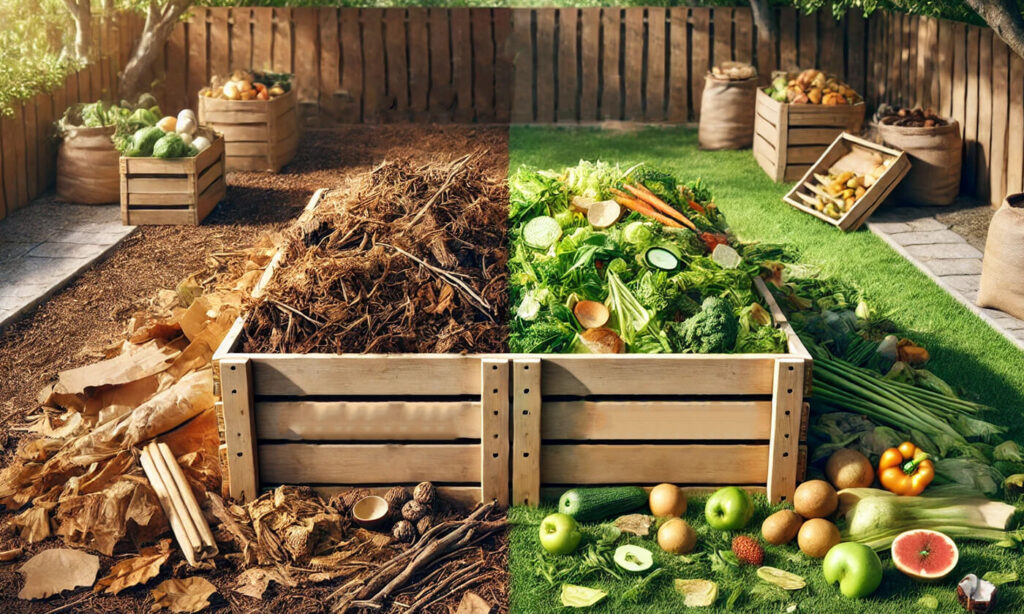Brown vs Green Materials in Composting

Composting is a fantastic way to convert your kitchen waste into a nutrient-rich treat for your garden. But, did you know that the secret to successful composting lies in the perfect balance of browns and greens? It’s not as simple as it sounds, though. The age-old rule of combining browns and greens in specific ratios isn’t always accurate and can lead to a compost pile that’s sluggish to break down or, worse, one that stinks up your yard.
Let’s debunk some common composting myths and misconceptions. The ideal Carbon to Nitrogen (C:N) ratio isn’t about the quantity of brown to green materials, but rather the carbon to nitrogen content. And while a certain ratio of browns to greens can be helpful, it’s not a one-size-fits-all solution. Your compost pile’s performance can vary depending on the specific types of browns and greens you use.
Key Takeaways
- Composting depends on a balance of brown (high-carbon) and green (high-nitrogen) materials, but it’s not a color-based categorization. Brow or green materials can display varied colors.
- Brown materials contribute bulk, aid in aeration, and absorb excess moisture from the compost pile, while greens fuel decomposition by feeding microorganisms.
- The ideal ratio for composting isn’t about quantity of browns to greens, but rather about managing a proper Carbon to Nitrogen content – a well-balanced ratio promotes efficient decomposition.
- The Carbon to Nitrogen ratio (C:N) doesn’t follow a one-size-fits-all value. It varies based on the compost’s components, requiring ongoing adjustments to maintain a healthy compost pile.
- Ideal composting includes appropriate layering of browns and greens, typically in a 2:1 ratio, with regular mixing to speed up decomposition and ensure a consistent compost texture.
- Troubleshooting common compost pile issues primarily revolves around adjusting the mix of browns and greens in the pile, managing moisture levels, and ensuring sufficient ventilation.
Understanding Composting Basics
Diving deep into the world of sustainable waste management, the intricate process of composting hinges upon finding the balance between brown and green materials. But what are these materials, what makes them distinct, and why are they a critical factor in composting? Let’s unravel these queries one by one.
The Role of Browns and Greens
Firstly, the term ‘brown’ in composting parlance refers to high-carbon materials. These may include poured and dried leaves, branches, and other dead plant materials. By contrast, ‘green’ references materials rich in nitrogen. This category encapsulates grass clippings, fruit and vegetable scraps, coffee grounds, and more.
Understanding the role of these elements forms the bedrock of successful composting. Browns play the crucial job of adding bulk and aiding in aeration, fostering the optimum environment for the compost to thrive. Besides, they absorb the excess moisture from the green materials, creating a balanced compost pile.
On the other hand, the function of greens isn’t any less significant. Rich in nitrogen, they essentially serve as food for the microorganisms that facilitate decomposition. An absence of greens, therefore, can undernourish these microorganisms, slowing down the composting process significantly.
A key insight to bear in mind is that the color of the material isn’t an indicator of its category. Quite often, browns can be green and vice versa – a truth that upends the common ‘brown and green’ rule.
Accurate composting isn’t about simply combining browns and greens in the correct quantities, but understanding and managing the carbon to nitrogen (C:N) ratio. And no, a 30:1 C:N ratio isn’t the ratio of browns to greens. Instead, it’s about the composition of carbon to nitrogen in your compost pile. It’s an intricate balancing act – one that requires diligence, but guarantees rich, fertile compost for your plants.
Keep in mind, establishing a well-functioning compost pile may take some trial and error. Different materials can influence the ratio and effective composting isn’t one-size-fits-all. The composition of your compost pile depends on your available materials and gardening needs.
With heaps of patience, a keen understanding of the role browns and greens play, and dedication to maintaining the proper C:N ratio, your composting efforts can bloom into a triumphant success.
Identifying Brown Materials for Composting
Recognizing brown materials for composting is key to achieving the ideal carbon to nitrogen ratio. Brown materials, despite their name, aren’t limited to a specific color category. Instead, they show variety with a spectrum that includes shades of gray, beige, and more. Remember, getting identified as a ‘brown’ rests largely on chemical and biological characteristics, primarily being high in carbon content.
Examples of brown materials encompass a range from leaves, wood chips to straw, among others. Fall leaves offer a carbon to nitrogen (C:N) ratio fluctuating between 30:1 and 80:1, contingent upon age and type. Wood chips usually harbor a C:N ratio on the higher end of the spectrum, while straw falls in a moderate range.
However, not all brown materials behave the same way in a compost pile. Factors like the material’s size and level of decomposition prior to composting can alter the rate at which the material breaks down. For example, shattered wood chips will decompose more quickly than larger chunks, impacting the overall C:N ratio dynamic within the compost pile.
More importantly, striking an appropriate balance between brown and green materials is crucial in composting. An excess of brown materials could slow down the decomposition process, while scarcity might cause the compost pile to emit an unpleasant smell. ChatColor no Repeat tweak balances accordingly if the compost pile stalls or becomes odorous.
Overall, understanding and identifying brown materials is the cornerstone for smart composting. A well-balanced compost pile, rich in high-carbon browns and high-nitrogen greens, results in nutrient-dense, fertile soil ready to nurture the next crop. Remember that this process requires a hands-on approach paired with knowledge and patience to derive optimum results.
Identifying Green Materials for Composting
When it comes to green composting materials, it’s not solely about the color. Green materials refer to compost ingredients high in nitrogen. These ingredients form the microbial life’s protein-rich diet, promoting faster composting.
Common green compostable materials include kitchen waste like fruit and vegetable peelings, coffee grounds, teabags, and grass trimmings. However, every variety comes with its own unique Carbon: Nitrogen (C:N) ratio. This ratio determines if a material is green or brown. For instance, coffee grounds, despite being brown, take a spot as ‘green’ compostables due to their lower C:N ratio.
Often, misconceptions arise concerning the C:N ratio. It’s crucial to clarify that this ratio isn’t about the quantity of greens to browns. Instead, it’s related to the carbon to nitrogen ratio within the compost pile. A balanced C:N ratio, around 30:1, microbially decomposes the organic matter in the compost pile more effectively.
Remember, using the right combination of green materials ensures effective composting. If the pile gets too green, it can become slimy, smelly, and slow to compost. On the flip side, too few greens can result in a compost pile that takes forever to break down.
So when you’re gathering your compost ingredients, understand that it’s not just about brown versus green or a simple rule of inches. It’s about the right chemical balance to promote decomposition. Your compost pile, rich in both brown and green materials, breaks down to create a nutrient-laden fertilizer for your garden, reducing kitchen waste and promoting a healthier environment.
Take the time to understand your green materials, their unique C:N ratios, and their role in the composting process. The successful compost lies not just in the color of your ingredients, but in the understanding of the science behind composting.
Optimal Browns to Greens Ratio in Compost
Crafting a superb compost necessitates striking an optimal balance of brown and green materials. Let’s delve into understanding the cruciality of this balance and how to accurately measure and adjust the ratio.
Why the Balance is Critical
A balanced compost pile with a harmonious blend of brown and green materials encourages swift and effective decomposition. Brown materials, teeming with carbon, lend structure to the compost while contributing to the energy requirements of microorganisms.
Conversely, green materials provide nitrogen, a core building block for the proteins your compost needs to thrive. An imbalance could engender a whole host of concerns. For example, an excess of green materials can cause a muddled and smelly compost pile. Alternatively, a surplus of brown materials often leads to a slow decomposing, dry compost pile.
Achieving a balance is paramount. It’s not merely about tossing in some nitrogen-rich green materials and carbon-rich brown ones. The heart of the matter is achieving the right Carbon to Nitrogen ratio (C:N) – a magic number, lingering around 30:1, that promotes optimal decomposition.
How to Measure and Adjust the Ratio
To obtain a compositional masterpiece of brown and green materials, you’ll need to measure and adjust the C:N ratio. But this isn’t as daunting as it may sound. On the one hand, brown materials like sawdust and straw have high C:N ratios of about 400:1 and 80:1 respectively. On the flip side, green materials such as coffee grounds and vegetable waste often exhibit low C:N ratios, offering a nitrogen boost to the decomposition process.
To get the balance right, the aim is to maintain a C:N ratio of around 30:1 in your compost pile. However, it’s not a one-size-fits-all measure! Based on what you’re composting, you’ll need to adjust your greens and browns accordingly. Typically, you’d do well with a rule of thumb of combining about two parts brown materials to one part green materials.
Remember, tweaking this ratio isn’t the end! It’s an exercise in iteration that demands constant fine-tuning based on what your compost pile demands. Observing your compost, adjusting the ratios, and experimenting purposefully, you’re likely to produce nutrient-rich compost for a thriving garden in no time.
Layering Techniques for Effective Composting
Optimizing your compost pile means employing the right layering techniques. Remember, every ingredient you use holds its unique carbon to nitrogen (C:N) ratio. Horse manure, for instance, boasts a ratio of 25:1, while fall leaves range between 30 and 80:1. Hence, layering isn’t just a mere stacking; it’s a strategic process to balance the resilient carbon-hearty ‘browns’ and the nitrogen-loving ‘greens’.
Uniform layering begins by introducing a healthy dose of browns at the base, acting as your compost pile’s foundational body. Here, commonly-used browns can include anything from straw, sawdust, or even the routinely discarded fall leaves. These items, rich in carbon, not only facilitate air circulation but also kickstart the composting process by providing energy to microorganisms.
Follow this with a layer of greens, the integral nitrogen providers crucial for protein production in your compost. Using greens like vegetable scraps, coffee grounds, or fresh grass cuttings, supply the necessary nitrogen quotient that aids the growth of protein-laden microbes.
The generally accepted layering norm is a 2:1 ratio of browns to greens. However, keep adjusting your ratios to cater to the compost pile’s evolving needs. If odors become a problem, add more browns to absorb surplus moisture while boosting airflow. On the contrary, if decomposition seems slow, up your green input to initiate greater microbial action.
By alternating between browns and greens, you create a compost ‘lasagna’, deriving maximum benefit from the unique C:N ratios that each material contributes – the key to achieving an invigorating, homebrewed compost success! Committing to regular mixing further enhances the composting process, speeding degradation and ensuring a consistent texture.
Mastering these compost layering techniques, constitutes an efficient pathway to nurturing a robust, healthy garden. Your reward for perseverance, a nutrient-rich homemade fertilizer, is simply a bonus on the landscape’s lush, colorful canvas.
Troubleshooting the Compost Pile
Compost pile troubleshooting isn’t as complicated as you might think. Often, when compost piles aren’t performing as expected, it’s due to common issues related to the moisture, ventilation, carbon-nitrogen ratio, or the mix of greens and browns. Let’s explore these problems in detail.
Common Issues and Their Solutions
If your compost pile isn’t breaking down as quickly as you’d like, the root of the problem may be an imbalance of brown and green materials used in your composting. Browns, being rich in carbon, provide microorganisms with energy, while greens, rich in nitrogen, provide protein, which facilitates their growth.
If your compost pile is excessively damp and has a foul odor, that’s a sign there’s too many greens, resulting in an overabundance of nitrogen. The solution here is to incorporate additional browns into your compost pile. The addition of brown materials like sawdust, straw, or cardboard absorbs the extra moisture and balances the heavy nitrogen content.
On the other hand, if your compost pile is too dry and has little to no decomposition going on, this could mean there’s a surplus of browns creating a high carbon concentration. In this case, increase your green materials example- vegetable scraps, coffee grounds, or fresh grass clippings.
Lastly, insufficient ventilation could be hampering your composting process. Composting is an aerobic process, requiring an abundance of oxygen for microorganisms to work efficiently. Turning the compost pile frequently assures proper aeration and speeds up decomposition.
Enhancing Compost Quality and Speed
With the variety of organic materials available, hitting the ideal carbon to nitrogen ratio might seem daunting. However, you don’t need to be exact about it. Ensuring a decent mix of browns and greens, and maintaining an optimal balance between them is your goal.
For fast and efficient composting, add thin layers of brown materials in between greens. This layering technique almost acts like a lasagna, providing the right environment for the breakdown of organic materials. Furthermore, maintaining the right moisture and turning your compost pile frequently can significantly enhance the composting process and the quality of your compost.
Remember, composting is nature’s way of recycling. It might not always align with recipes and guidelines, with the complexity of organic matter being composted at play. The best way to get it right is through trial and error, adjusting ratios, moisture, and aeration as you go, and keeping a keen observation of your compost pile.
Frequently Asked Questions
Are coffee grounds considered green or brown compost?
Used coffee grounds are classified as green compost materials. They are high in nitrogen and provide vital protein to microbes in a compost pile, promoting efficient decomposition. They also help plants convert sunlight into energy.
Are coffee grounds good for compost?
Absolutely. Coffee grounds are a beneficial addition to a compost pile. Composting coffee grounds contributes valuable nitrogen to the compost pile, assisting in the breakdown of other organic matter and creating a rich soil supplement.
Are eggshells green or brown compost?
Crushed eggshells are listed among green compost materials, which generally include things like fruit and vegetable scraps, used tea and coffee grounds, grass clippings, and green plant debris. Brown compost materials, on the other hand, typically consist of straw, paper, cardboard, dried leaves, and woody prunings.
What are the green and brown components while composting the garbage?
Green components in composting include materials high in nitrogen, such as vegetable peels, fruit scraps, coffee grounds, and grass clippings. Brown components are high in carbon and include dry leaves, straw, wood chips, paper, and cardboard.
Are dead leaves green or brown compost?
Dead or dry leaves are considered brown compost materials. Brown compost materials have a high carbon to nitrogen ratio which is beneficial for composting. However, be cautious about walnut leaves, they contain substances that can hinder the growth of many other plants unless fully composted.






